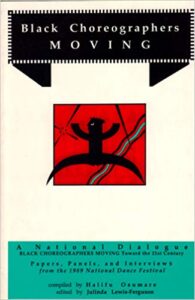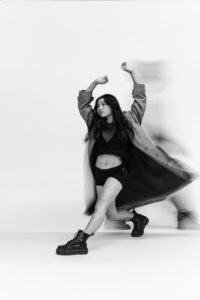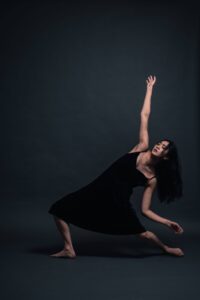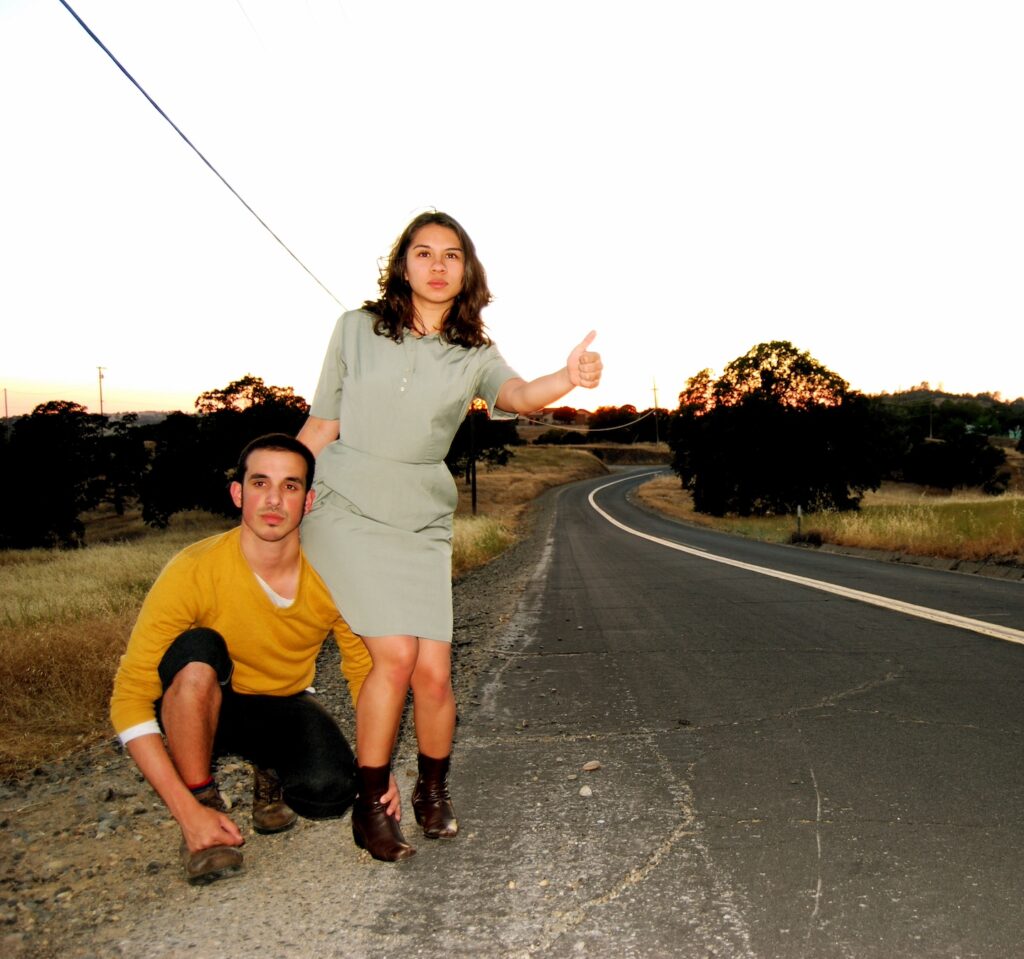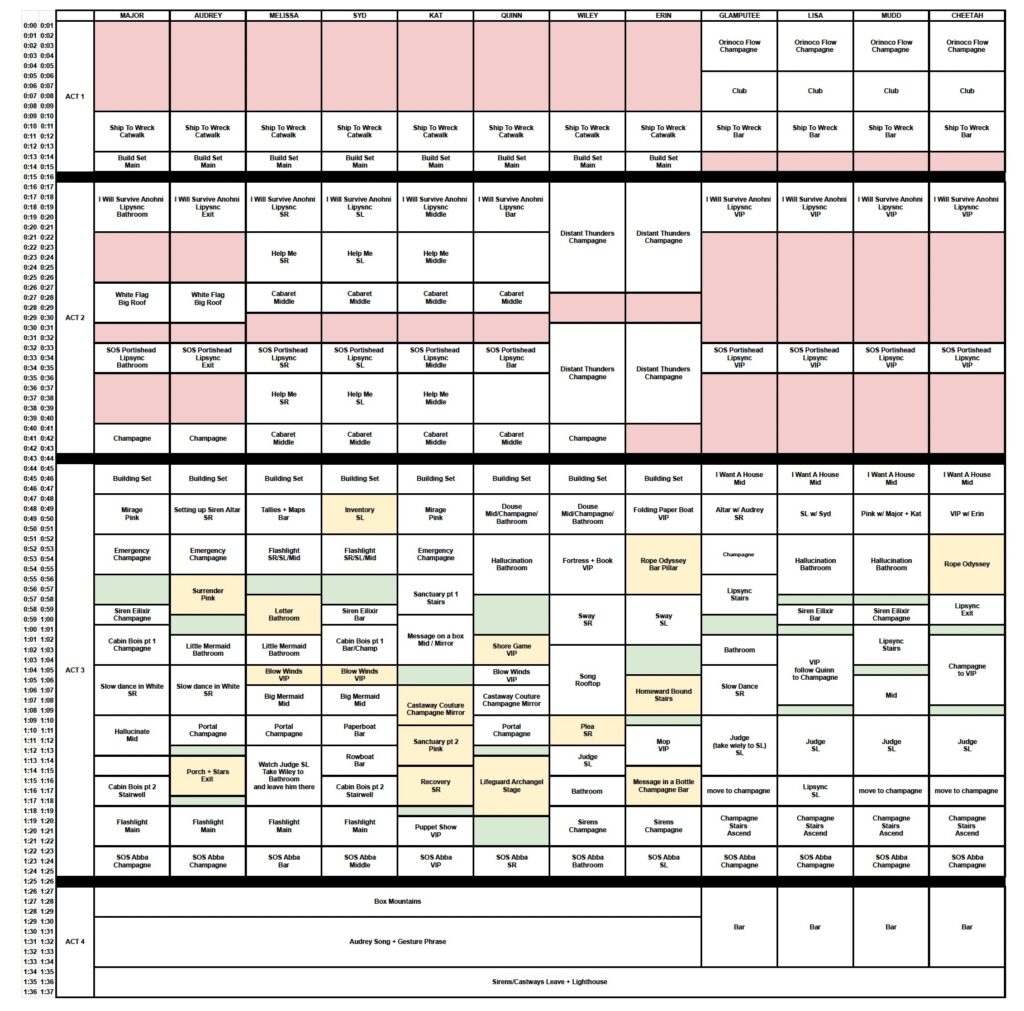Shareen DeRyan. Photo by Afshin Odabaee.
[ID: A Black woman dances gracefully in a rundown ivory building with graffiti-covered walls. She performs an arabesque in a flowing black dress adorned with floral patterns. Her arms are extended open and reaching back, her hair cascading down, adding to the elegance and contrast against the gritty back]
When we co-founded Bodies of Empowerment (BOE) in 2021, we were driven by a shared belief—dance should be a resource available to everyone, not just those with the financial means to access it. In the wake of the challenges posed by the COVID-19 pandemic, it became clear that dance needed a space where people could feel empowered, and where their bodies could find expression without financial barriers. In response, we founded Bodies of Empowerment, a program that offers adults of all ages a one-of-a-kind selection of dance classes led by highly trained instructors at no cost. Now, BOE has grown into a thriving program that has impacted over 600 individuals and continues to support dancers and instructors of all backgrounds.
The Beginning: A Response to Need
Our journey began in response to a significant gap we observed in the dance community. Both of us spent years scraping by to pay for dance classes while earning minimal wages to teach them. The pandemic only deepened these challenges, with many studios closing their doors or raising rates to stay afloat. We realized that for dance to truly embody empowerment, it must be accessible to everyone. Our classes aim to bring people together—dancers and non-dancers alike, those with disposable income and those with less—creating a space where everyone feels included and valued.
Shareen’s passion for BOE’s free classes stems from her own struggles with the cost of dance training. Starting at a young age, she faced financial hardships in affording tuition. To offset costs, she took on janitorial duties in exchange for class access, a dynamic that often left her feeling unworthy or embarrassed. This tension extended to her family, with frequent conflicts over unpaid tuition, and persisted throughout much of her training. These financial barriers not only created stress but also highlighted how the high costs of dance training exclude many communities, particularly those historically marginalized.
For Kristin, the imbalance between time spent preparing and teaching classes and the income earned was stark. Some studios offered pay structures as low as $5 per student with no base rate, making earnings contingent on self-promotion and popularity. While a few studios implemented base pay or 50/50 splits, these models often lacked growth potential, perpetuating a cycle of financial instability for teachers.
With the help of our friend and colleague Styles Alexander, who was instrumental in shaping the early vision of the program—initially imagined as a platform for festivals and youth programs—we officially launched Bodies of Empowerment in 2021 as a free dance class initiative.
Fostering Inclusivity Through Diverse Styles
One of the things that makes Bodies of Empowerment unique is its commitment to showcasing diverse dance styles, thereby fostering inclusivity by challenging the dominant racist focus on Eurocentric dance forms. We offer instructors from various dance communities opportunities to teach styles such as Umfundalai, hip-hop, vogue, intergenerational dance, drag theater, and more— creating a broad spectrum of experiences within a single program. This not only reflects the diversity of dance in the Bay Area, but also allows participants to engage with movements and traditions they may not have had access to otherwise. Classes are offered at different levels from Beginning to Advanced, and oftentimes classes are “All Levels.” Our hope is to create a space where people can try a new style of dance without expectations or judgment. Our all-level classes welcome everyone from professional dancers to complete beginners, fostering an environment where learning with each other, being present in your body, and sharing the experience of discovery are what matter most.
Empowering Teachers and Building Sustainable Support Networks
Our approach also empowers our guest teachers by involving them in marketing decisions, contract drafting, and editing. This ensures that our teachers have autonomy in shaping a welcoming space for their communities and helps create an environment where they feel supported.
Many of our teachers work across the Bay Area and beyond, extending the reach of BOE by connecting participants to their other non-BOE classes. This network amplifies their impact and creates sustainable support systems for those needing ongoing dance classes or community resources. As a result, Bodies of Empowerment fosters long-term engagement in the dance world and contributes to the growth of strong, supportive networks for dancers in the Bay Area.
The Real Cost of Free Classes
A diverse, inclusive dance scene enriches our culture, fostering creativity and collaboration that transcends socioeconomic and cultural divides. The dance world has long been criticized for its exclusivity, where access to classes and opportunities is often limited by one’s financial status. Bodies of Empowerment seeks to dismantle these barriers by offering dance classes at no cost.
Offering free classes is a beautiful thing, but it’s not without its financial challenges. For each Bodies of Empowerment class, we spend almost $500 per class: $175 to pay our instructors, $100 for space rental and insurance, and $200 in administrative costs (even with donating some of our own time). That adds up quickly, especially when the goal is to keep these classes free for participants. While we do accept donations, we intentionally don’t push for them, knowing that for many of our participants, having the ability to dance without financial strings attached is absolutely crucial. Dance should never be out of reach because of a person’s income level—that’s something we hold at the core of our mission.
“Free” does come with some complexity. While we are committed to offering free access to dance, we also believe in the value of dance classes themselves. In many fitness and wellness spaces, the cost of a class can be double what you might pay for a dance class, despite the fact that dance requires just as much (if not more) skill, expertise, and physical effort. By paying our instructors fairly, we aim to raise the standard for how dance educators are compensated and, in doing so, elevate the value of dance classes themselves.
The Role of Funding and Looking Ahead
For the past three years, Bodies of Empowerment has been sustained in part by portions of Kristin Damrow & Company’s (BOE’s parent company) California Arts Council General Operating Grant. However, as those funds are now nearly exhausted and unable to fully meet the growing needs of our community, we find ourselves seeking new support to continue this vital work.
As our program continues to grow, we are committed to expanding our impact, reaching even more participants, and creating a lasting legacy of inclusivity and empowerment in the dance world. But we cannot do this alone. We are actively seeking additional funding and partnerships to ensure that Bodies of Empowerment remains a sustainable and accessible resource for all.
We are so grateful to all the participants, teachers, and community members who have supported us on this journey. Without their passion, dedication, and energy, Bodies of Empowerment would not be what it is today. Together, we’ve proven that when dance is made available to all, it has the power to change lives.
Come take class for free! Visit us at boe.dance for all of our classes and ways to support!
This article appeared in the Winter 2025 issue of In Dance.
Shareen DeRyan received her initial training at Ballet Arts Academy in Spokane, Washington and continued training at Lines Ballet in San Francisco. In the Bay Area, she is a freelance dancer and has danced for companies like Kristin Damrow & Company for five years and Kinetech Arts for three. She has performed in various works for companies like Fullstop Dance, Mud Water Theatre, Bellwether Dance, ZiruDance and Rawdance. She has performed in works by choreographers like Sidra Bell, Jon Kinzel, Christian Burns, Robert Moses, Mark Foehringer, Christy Funsch and more. Currently Shareen is in her seventh year of dancing for JenniferPerfilio Movement Works. Alongside freelance dancing and co-directing BOE, she also owns a Reiki and sound healing practice.

